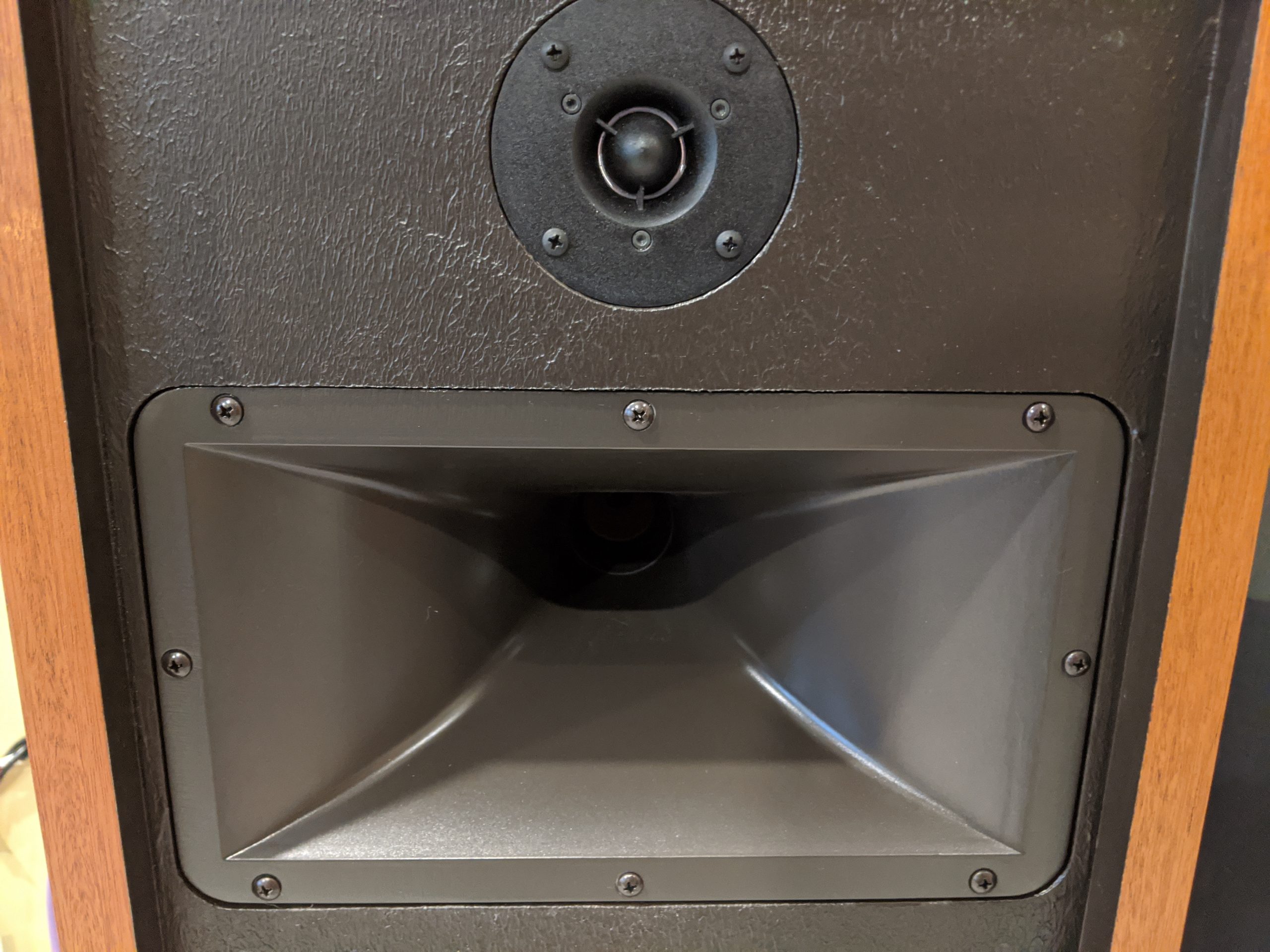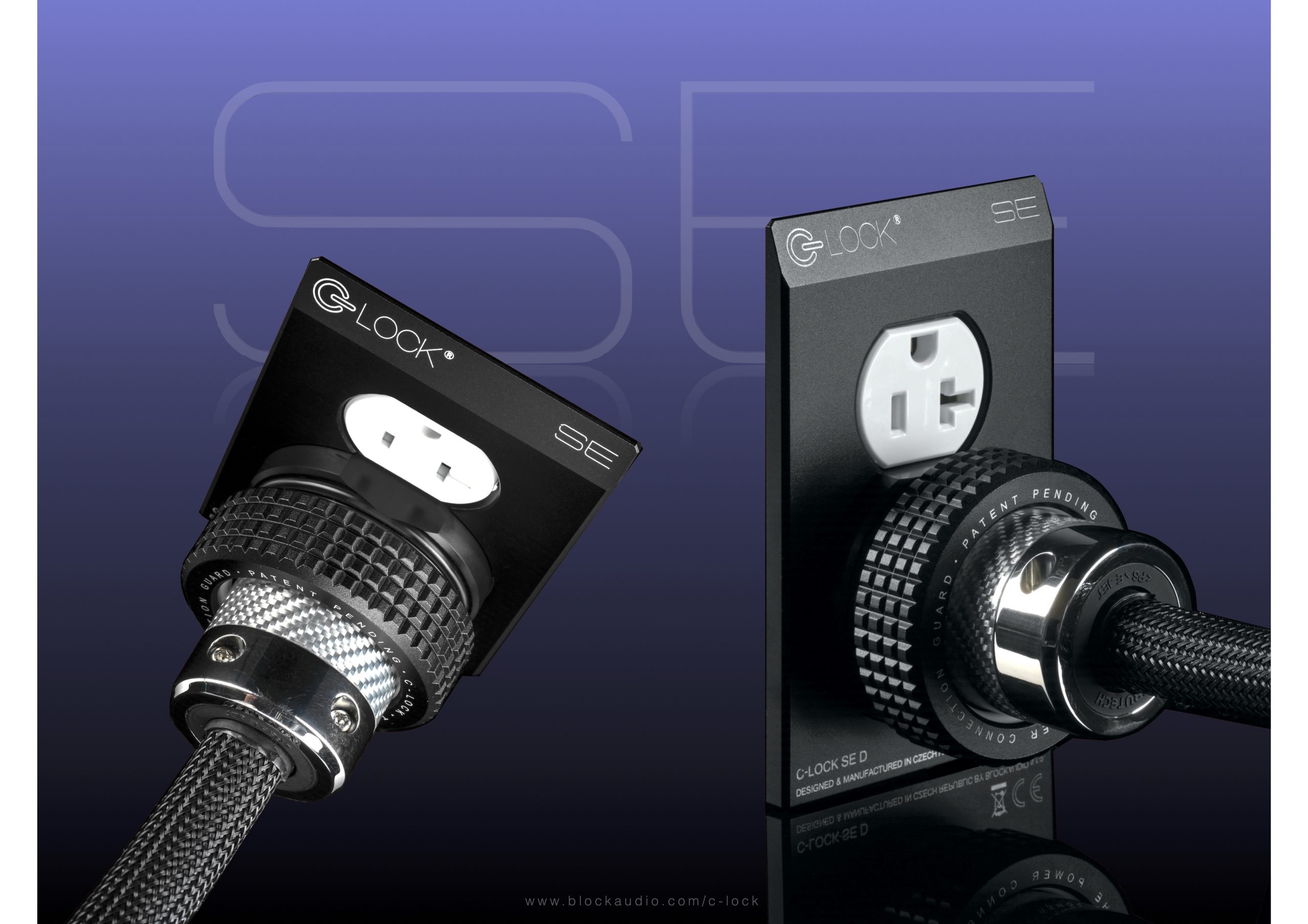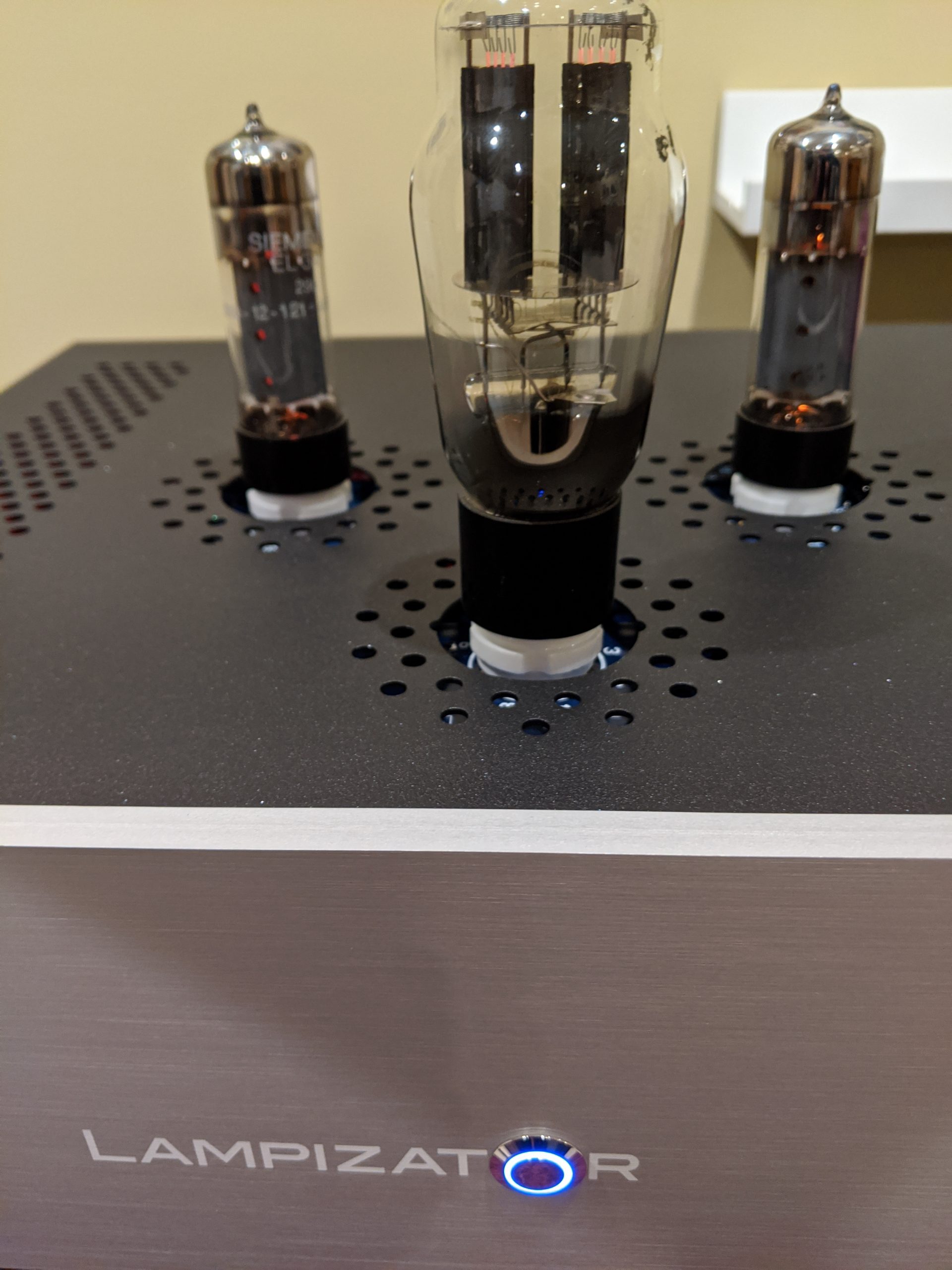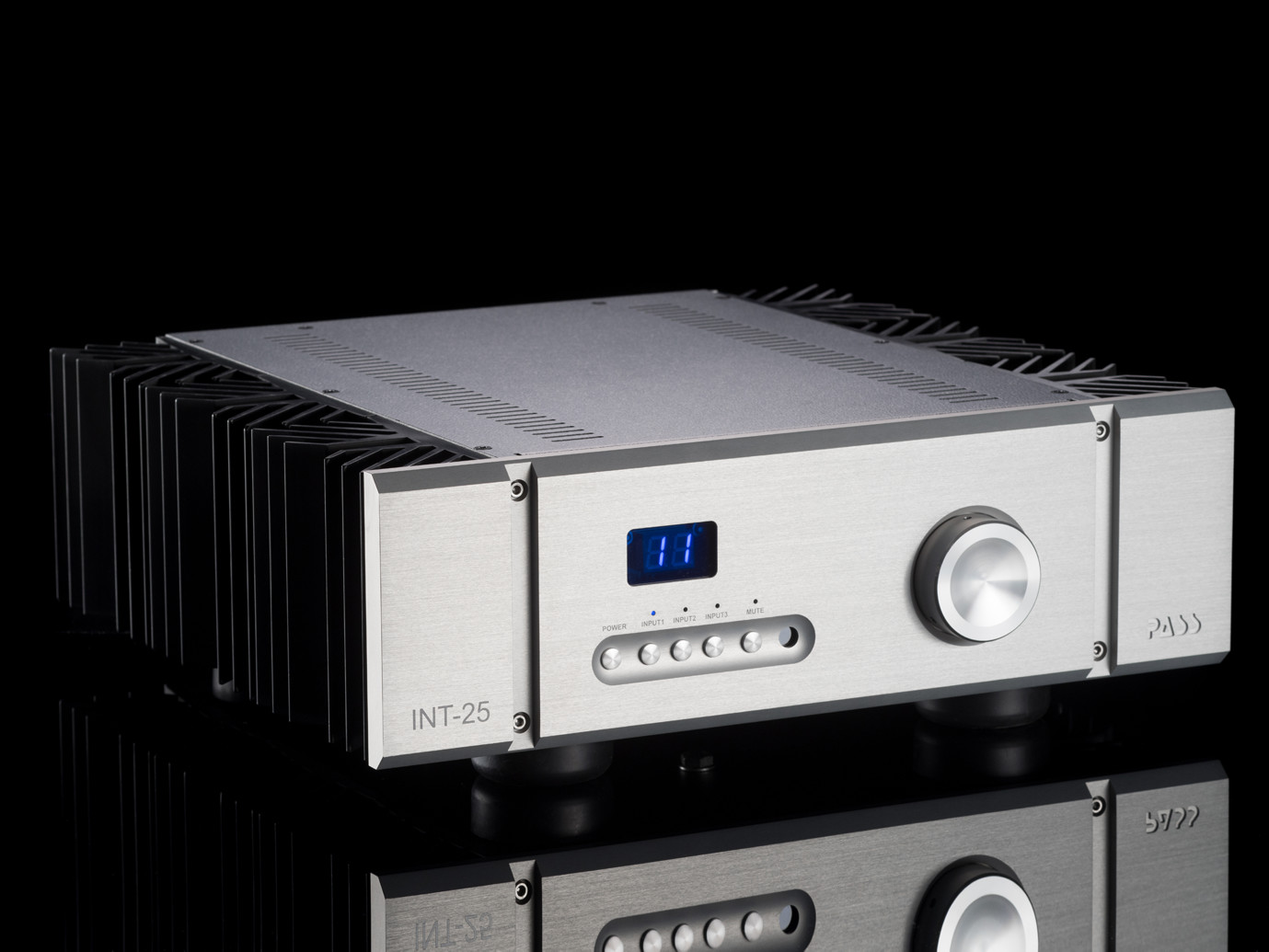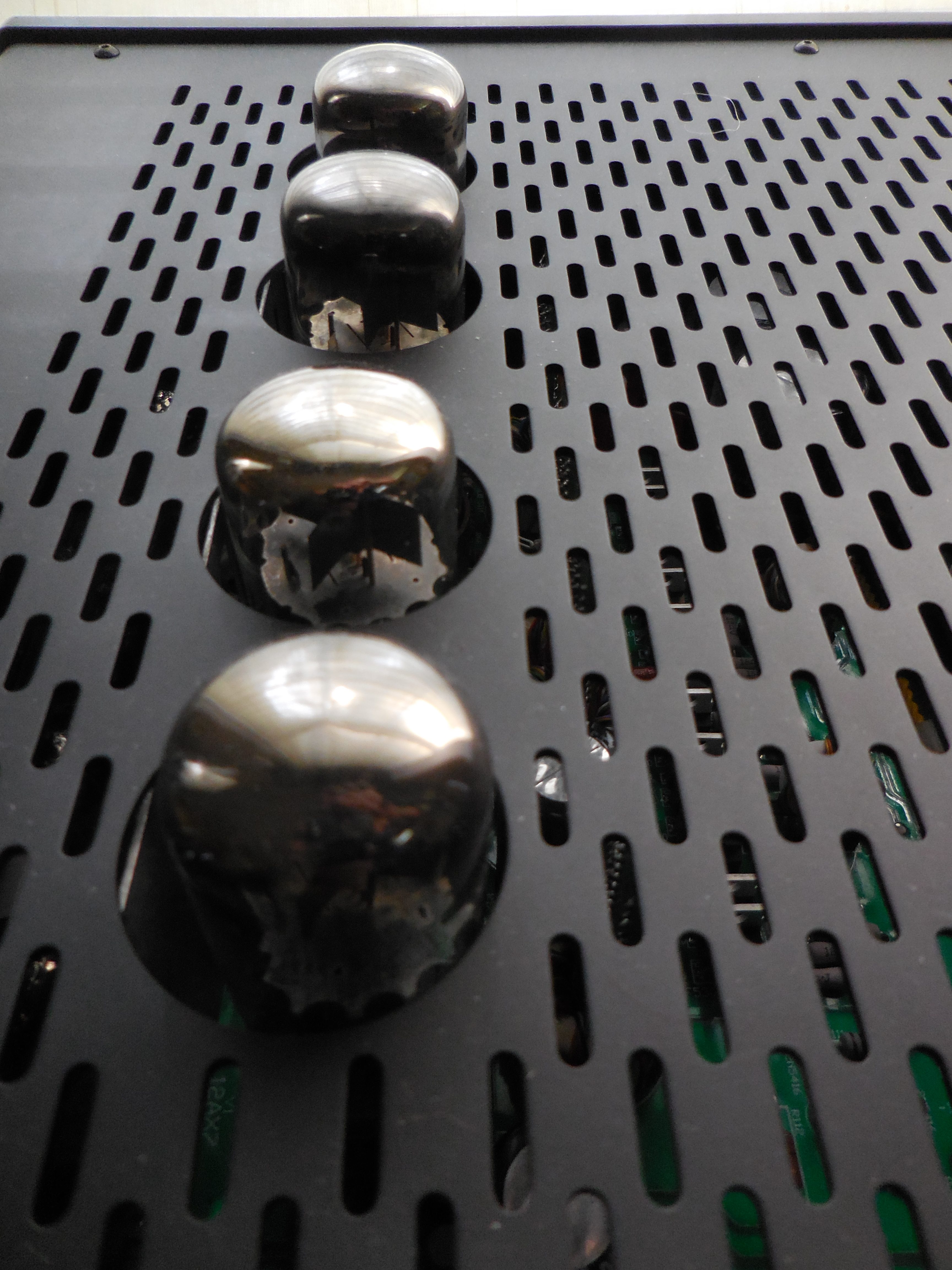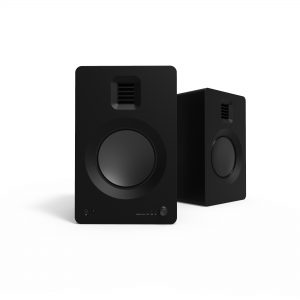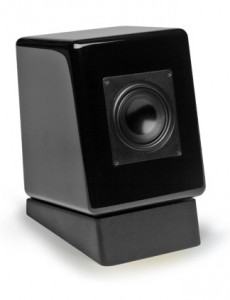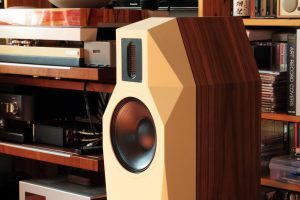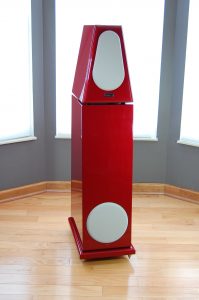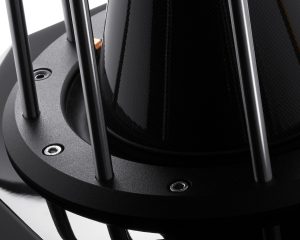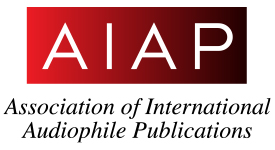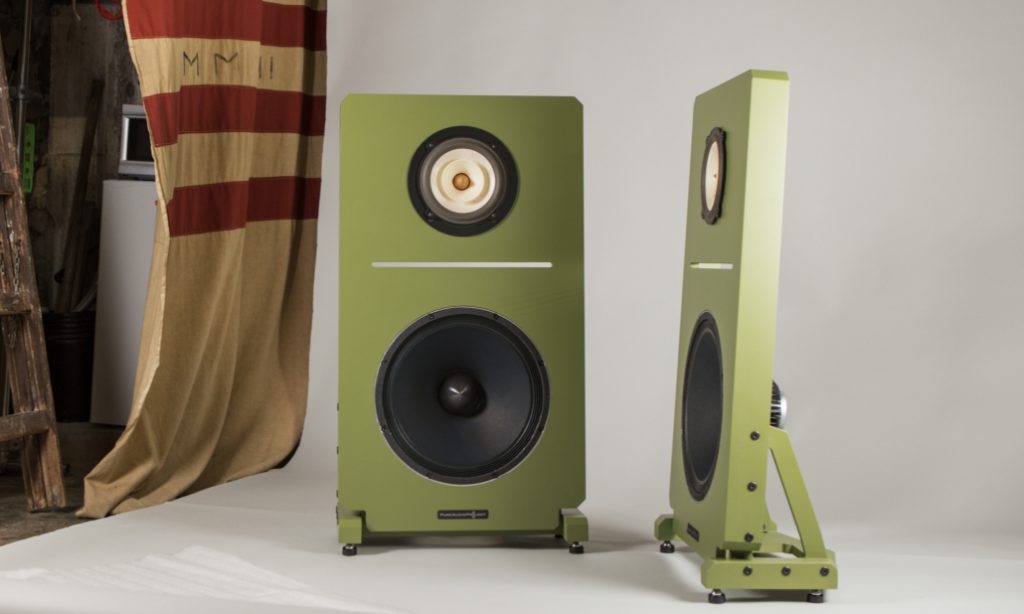
Unless you have been living under a turntable weight, you are likely aware of PureAudioProject.
Founded in 2013 by Ze'ev Schlik, the collaborative PureAudioProject (PAP) offers a line of highly regarded modular open baffle loudspeakers using interchangeable upgradable frame structures, drivers, and crossovers. In addition to the modular speakers, PAP has expanded its product line, now offering pre built loudspeakers, including the subject of this review, the new Duet 15 Prelude.
Duet 15 Prelude General Specifications:
- Sensitivity: 96dB (in a typical room)
- Nominal Impedance: 8ohm
- Frequency Range: ~29-32 Hz – 20 kHz (in a typical room)
- Finishing Options: White, Black, Blue, Green, Red
- Size: W:54cm H:99cm D:27cm | W:21.25" H:39" D:10.63"
- Weight: ~15kg | 33lbs
Designed by Ze'ev Schilk, and industrial designer Omri Gino; the Duet 15 Prelude is a two-way open baffle loudspeaker featuring an 8" full range driver, and 15" woofer. The frame/baffle, and 2nd Order crossover are unique to the Duet 15, while the high-end drivers have been used in other PAP models. The imposing 15" OB-A15Neo woofer (HERE) features a neodymium motor, and is built to PAP spec by Eminence specifically for open baffle speakers. A choice of a full range driver is customary for PureAudioProject, and there are two available for the Duet: The lower cost Tang Band W8-1808 8" full-range driver, or the Voxativ AC-1.6 (HERE); the wideband driver of choice for the review pair of Duet 15 Preludes.
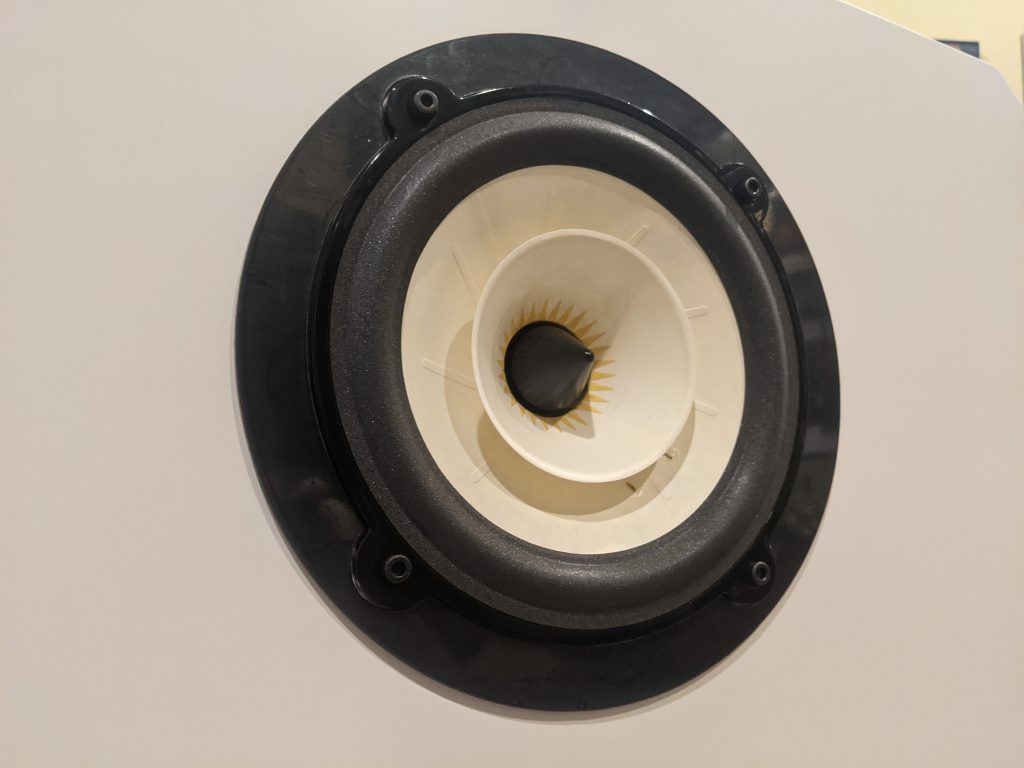
In addition to high quality drivers, the Duet 15 Prelude employs electronic parts by well regarded audio manufacturers, Mundorf, and Klotz Cables. The Mundorf crossover board utilizes screw terminals for connecting resistors. This allows the end-user to change resistor values depending on which full-range driver option is chosen. This can also allow the owner to tweak the driver output by +1 dB or -1 to -2 dB using the included selection of resistor values. The crossover, which uses Mundorf inductors, and two different types of Mcap capacitors is surely a contributor to the Duet's sonics. I've used Mundorf caps in past amplifier projects, and have always loved their smooth, relaxed sonic signature.
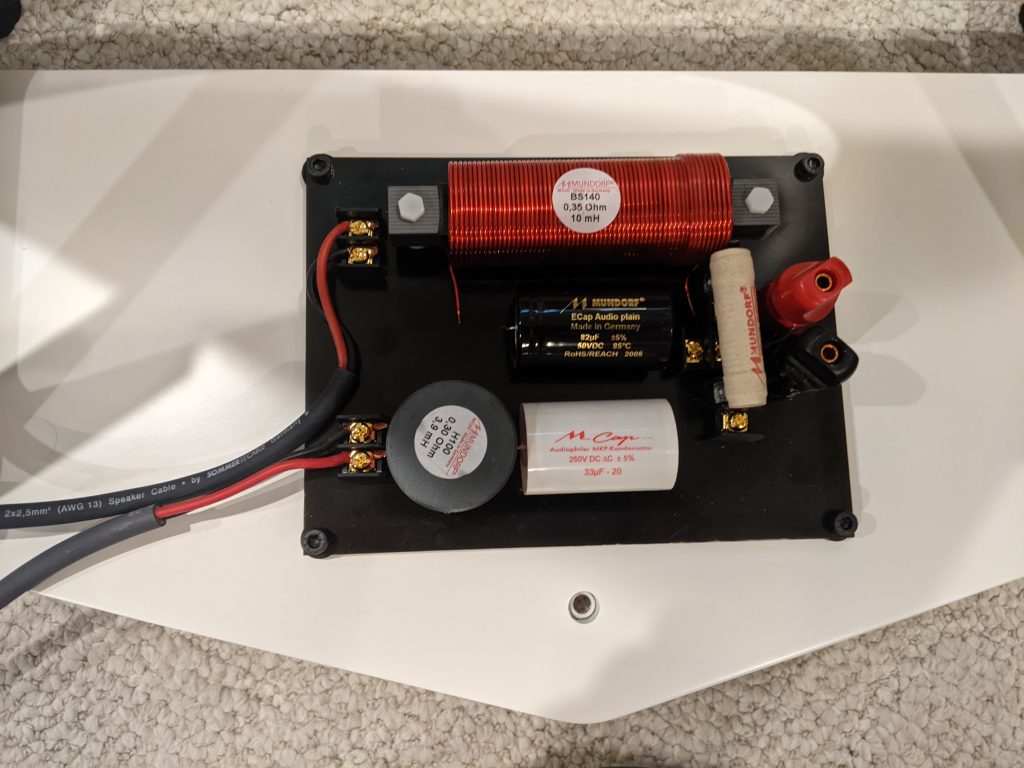
The review Duet's well-made hardware, and nicely finished White Matte painted wood frame are sourced from manufacturers in the USA. According to PAP, the horizontal slot in the middle of the frame helps control vibration, while separating the drivers to enhance visual beauty. The Duet comes with four round "feet" for supporting the speaker. All four can be used on the corners, or optionally, three can be used with two in the front, and one in the center rear. I opted for the 3 footer triangle configuration. I was initially concerned about potential vibration, as well as stability on my carpeted floor. I never noted an issue with either. In a long term situation, I'd probably opt to add size M8 carpet-piercing spikes, but the supplied feet worked very well, and the speaker always felt stable.
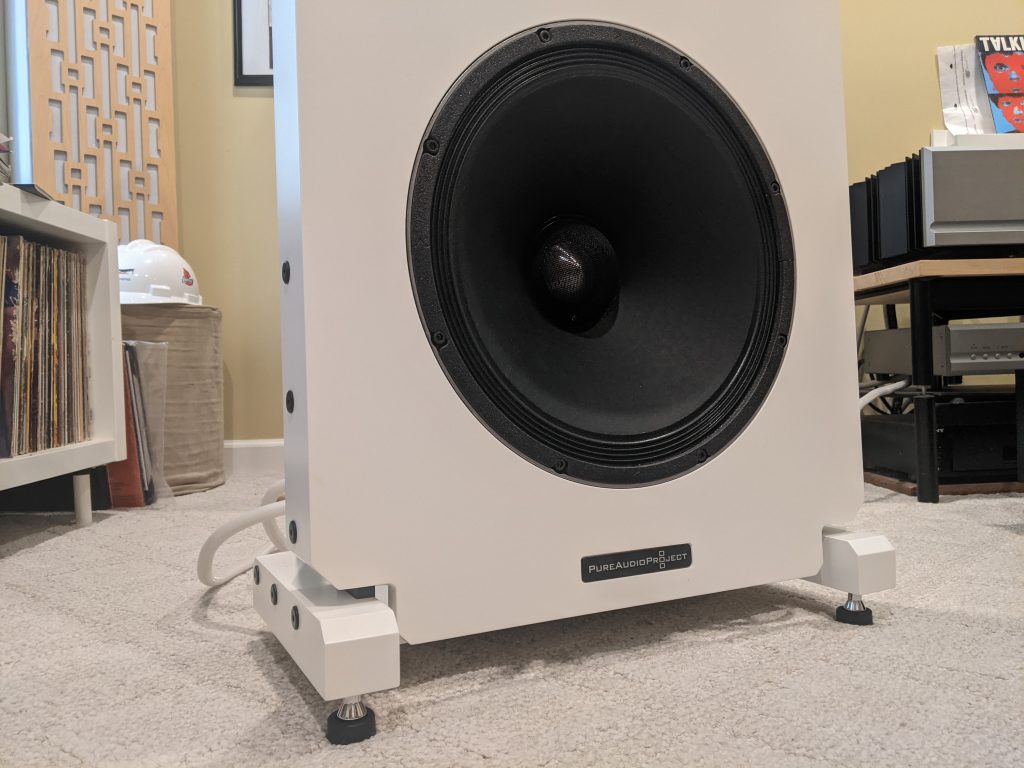
Of note: Although the Duet 15 Prelude is pre-built rather than modular, there is some assembly required. While PAP modular speakers require complete assembly of all parts, baffles, frames, drivers, etcetera; assembling the Duet is more straightforward: There are 12 bolts to install for each frame, then screw in the feet, and the basic "enclosure" is done. Install the drivers, screw down the plate-mounted crossover, and hook up the cables from the crossover to the drivers. And lastly, install the adhesive backed diffusion ring on the 8" driver.
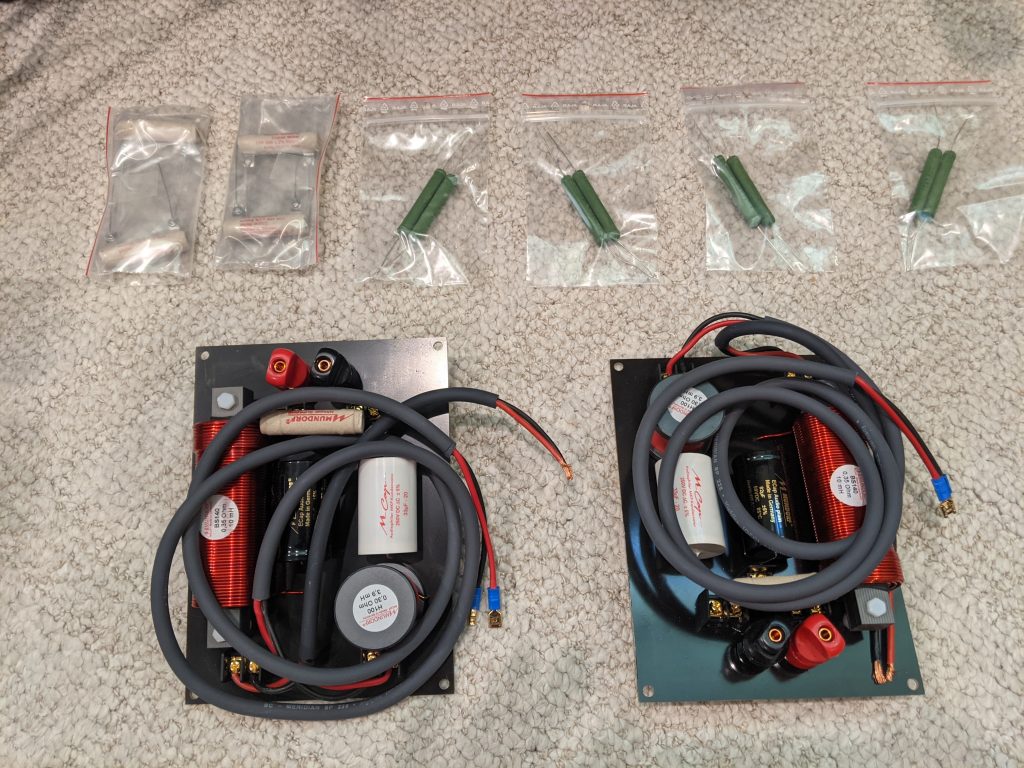
Mundorf Crossovers, Klotz Interconnect cables, and Resistors.
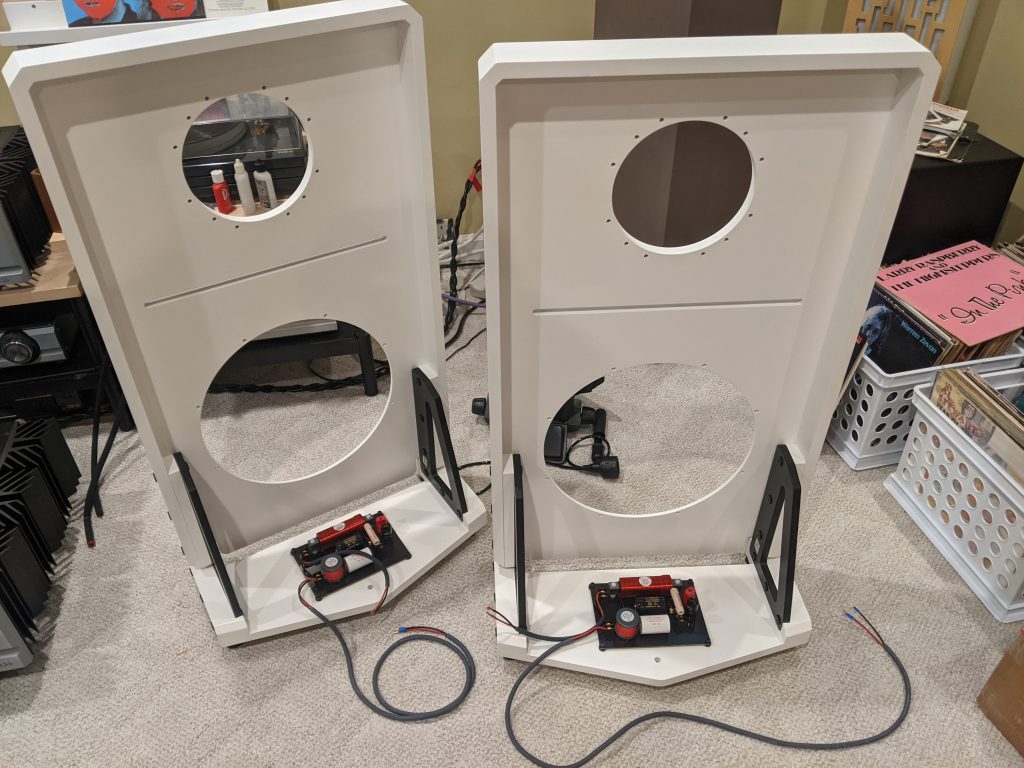
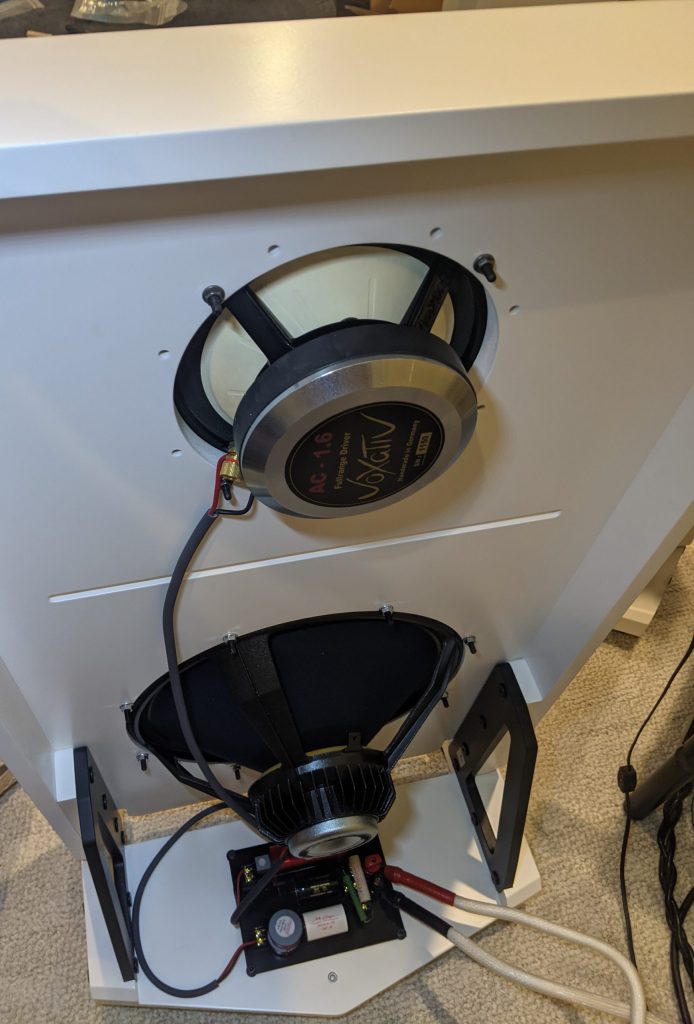
And it's a done Duet! It took me about two coffee breaks to finish.
Openly Baffled!
The PureAudioProject Duet 15 Prelude is the first OB loudspeaker to grace my listening room. I must say, I was immediately impressed. If, as the name suggests, the Duet 15 Prelude is PAP's prelude to their more accomplished speakers, then it is no wonder why PureAudioProject is getting so many positive reviews. As a dipole, the Duet 15 Prelude radiates sound waves from both front and rear, each out of phase with each other. This can (and in my Duet experience, does) create a more expansive, and natural sound. The Duet required quite a bit of breathing space, and they sounded best when at least 3 feet away from the front wall, slightly delaying the back wave bouncing off the front wall. But first...
Break-in Again?!?! Arrrrrgggh!
These speakers do need to be broken in...A lot. A whole lot.
I like to listen intently from day one; even as a new speaker churns between good, and bad. Confusingly perhaps, the Duet 15 Prelude actually sounded pretty good out of the box. But after a few hours of play the drivers "tightened up," and from that point on the Duet went through such a gauntlet of sonic gyrations that made me wonder if the hamster wheel of change would ever stop. Yes, a bit of hyperbole perhaps, but indeed, there were days that they didn't sound very good at all. But that is not the end of the story. The Voxativ drivers were a little zippy, and lean at the outset, but as they loosened up, the AC-1.6 became increasingly more full, smooth, and quick. The Neo woofer was more compliant in its time to wake, yet no less complex, sounding muffled, and muddy at times. Glimmers of good sound were heard throughout the process, so I knew the speakers would ultimately gel, but it took approximately 200 hours of medium volume play. Every user will have their own experience, and doubtless some will think this break-in assertion is crazy, but I maintain...Two hundred hours plus… Have patience!
Set Up
Although my room offers lots of free air for sound waves to develop, the actual listening area is only 16' wide x 12' deep with speakers along the 16' wall. That doesn't allow for much distance behind large speakers without being nearfield at the front. The thin profile of the Duets made it possible to give them the required space off the wall without being in my face.
After much experimentation, I ended up with the speakers 42" off the front wall, and 48" from the sides to the center of the drivers. This put the speaker-to-speaker center at approximately 7 feet, and slightly more, at 7'-2" from driver to my nose at the listening seat. I experimented with toe-in, and found many angles—including straight on—to have positive virtues. My favorite position was with the speakers toed-in just enough to fire outside my shoulders. It should be noted that in my well-damped room, the front wall to speaker distance was incredibly important for good tonal balance. Too close to the front of the room, and the bass simply overwhelmed the treble. Subtle it was not.
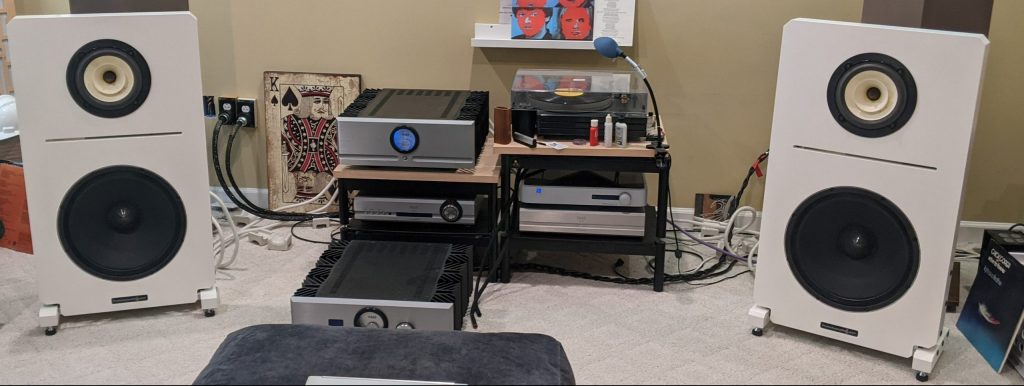
With position locked, break in complete, and center seat occupied, it quickly became clear how well the Duets play music. Their excellent resolution digs deep, exposing the uniqueness of every recording. Inès Vogel's Voxativ AC-1.6 is a terrific transducer. I was quite taken with its ability to resolve detail while remaining smooth, and musical, especially in the midrange. The Duet's crossover point is fairly high (the specific frequency is kept close to the vest by PAP), allowing the 15" PAP-Eminence woofer to strut its stuff too. It moves a lot of air while adding a dash of musical warmth. Like the Voxativ, the woofer has good clarity throughout its frequency range—every note distinct, and musical, yet it blends seamlessly with the Vox. The woofer is fast, and packs quite a visceral punch. As a speaker system the Duet's transparency is high, and integration of the two drivers is excellent. Predictably for my age, my ears don't hear anywhere close to 20kHz, but the treble I do hear is very good, but never overpowering. Bass goes very deep, and did not require the addition of a subwoofer in my room. Midrange. Ahhhh yes. The midrange is the wonderful highlight of the Duet, at times eliciting a soft but absolute wow from this listener!
No tubes, No Problem!
Of course, I'd love to hear the Duet 15 with tubes, but since that didn't happen, I dug through my old audio toolbox, and found a few solid state amps I thought might make the grade.
Along with my reference Pass Labs XP-12 preamp, I alternated between two class A amps; the Pass Labs XA 30.8, and First Watt F7. The Duet 15 Prelude is relatively easy to drive, but I found they enjoy a bit of power too; so I swapped in the class A/B power of a Pass Labs INT-60 integrated amplifier for a change of pace. The First Watt F7 was great; sounding best when turned up near the very top of the XP-12's volume range. The F7's imaging, staging, and gorgeous midrange resolution were on full display. The INT 60 sounded more lean than the other two amps, but the fast powerful dynamics were impressive. The Tune Saloon's reference XA 30.8 was a fabulous partner. Clean, clear, layered, and powerful, it sounded so fantastic, I kept turning it up louder, and louder until it was clearly starting to become a little harsh at the top. In general, I listened to the duets at a much higher volume level than normal for me.
Listening with three amps I know well showed the Duet 15 passes the signal in a relatively unaltered state. The Voxativ and PAP/Eminence drivers certainly add their own sonic spice; perhaps a tinge of dry neutrality from the Vox, balanced by the room-filling richness of the woofer.
Special Little Things
For all its outward simplicity, the Duet 15 Prelude's sonic quality is quite complex. It is dynamic, with a lightning fast attack. Resolution of fine detail is excellent, and tonal color is strikingly lifelike at times. The Duet also gets high marks for an amazing ability to construct a believable image, and set those images into a wide stage. The center image is especially solid, very deep, and quite realistic. Add in Duet's very nice front to back layering, and you have the recipe for reproducing exciting musical illusions. During my audition, it was not unusual for well recorded music to reach out in three dimensions to comfort, even confront, me at my listening chair.
I didn't realize until the night I took the Duet 15 Preludes out of my system how well they produce freely flowing low to low-mid frequencies. Bass is much more enveloping than the tightly controlled bass impact of my reference VSA VR-35s. Despite the great bass performance, and willing high frequencies, it was the midrange of the Duet 15 that most often caught my attention. It is quite addictive, and I will admit to missing it after disconnecting them.
What I like about the Duet 15 Prelude
- Fast, deep, warmly resolved bass.
- Solid dynamic performance.
- Tonal realism.
- Fabulous imaging, and excellent staging.
- Terrific fun turned up loud!
- Clarity, space, and layering.
A Lovely Time
During my time with the Duet, I listened to almost every genre of music. And while some speakers are more capable with one type of music or another, the Duet sounded sterling with them all. I especially enjoyed raucously sparse, jangly rock n' roll, as well as large scale orchestral works. One evening I was transported to a galaxy far away while listening to one of John Williams' film soundtrack spectaculars. Turned up fairly loud (smiling), the Duet's dynamic power was on full Star-Wars-display. It's a good thing my light sabre was stored safely in the closet.
Although the speaker does lose a bit of dynamic contrast at very low levels, listening at low volumes is good, and the Duets scale up and down without too obvious a difference in sonic personality. But I think it is fair to say the Duet 15 likes to be played loudly, and I will admit, it is very hard to keep the finger off the "volume up" button with these speakers. There is a small window in my system where higher volume (and higher power) translated into a significantly better dynamic performance.
It should be noted, that while the Duet 15 Prelude sounds free, and relaxed, it is a fairly truthful speaker too. But bad recordings were never unlistenable, just noticeable. Even when a little ugliness showed itself, there was always a sense of effortlessness, and at times, total immersion in the performance.
Yeah. Very good.
The "Realness" Factor
Recording dependent, the Duet's spatial effects can be quite remarkable; but without reasonably correct timbre, all the 3D floating tricks would mean little. I've heard live music of all kinds but I would never be silly enough to say the Duet 15 makes recordings sound like the real event. They can, however, render a lovely musical portrait with excellent tonal color, and the kind of dynamic intensity that results in an occasional willing suspension of disbelief. It has given me goosebumps more than a few times.

Toward the end of my audition time, I spent a spellbound evening glued to my seat listening to the Yes compilation, The Steven Wilson Remixes. Streaming beautifully from Qobuz via Roon Labs, every song had effortless dynamic impact and glorious 3D staging. The opus "Close to the Edge: The Solid Time of Change/Total Mass Retain/I Get Up I Get Down/Seasons of Man" was 18 minutes and 47 seconds of Prog Rock Heaven.
Yeah. Very good!
OB Wrap
Although Ze'ev Schlik says the Duet 15 Prelude could be a stepping stone, its performance in the Tune Saloon clearly demonstrated the Voxativ equipped Duet is anything but entry-level. It could certainly be an end-game for many. I'll say this without hesitation: The Duet 15 Prelude is a first-rate loudspeaker that tickled every single personal sonic-fancy. I cannot imagine anyone with suitable equipment, and a properly sized listening space not enjoying it. As for me, I could live with this speaker, and be very happy.
Most highly recommended!
Duet 15 Prelude Loudspeakers with Voxativ AC-1.6
Retail: $5990 USD, Direct sales only
Standard frame colors: White Matte, Black Matte, Blue Matte, Green Matte, Red Matte
Shipping (+$150), Optional Grills (+ $180) Optional Bamboo finishes (+$400).
PureAudioProject
USA Toll Free: 877.927.2233
Europe: +49 69 29917675
WhatsApp and ROW: +972.54.258.4258
Fulfilment from the USA from:
PureAudioProject LLC
IA, 52246, USA
Fulfilment from Europe from:
PureAudioProject UG
63128 Dietzenbach, Germany
Fulfilment ROW from:
PureAudioProject LTD.
5225511, Israel




